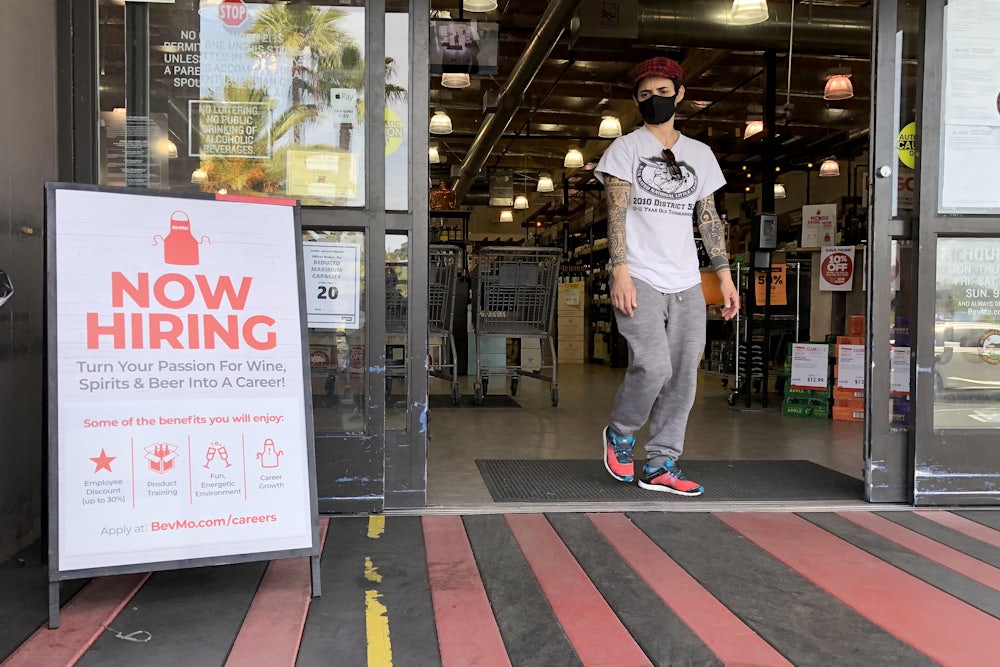A central problem in labor economics is how to raise wages without first killing off a significant portion of the workforce. Plagues have historically reduced income inequality by reducing the labor supply, with the necessary caveat that in order to enjoy this higher standard of living the worker in question must remain one of the living. The Covid-19 pandemic is following this pattern.
One year into the crisis, the Bureau of Labor Statistics reported that average hourly earnings were up 21 cents, suggesting that “the rising demand for labor associated with the recovery from the pandemic may have put upward pressure on wages.” McDonald’s announced last week that it’s boosting wages by approximately 10 percent at its company-owned stores. Bank of America said earlier this week that it’s on track to boost its hourly wage minimum to $25. This is all happening because Covid-19 killed more than half a million people during the past year.
The relationship between mortality and rising wages is more complicated today than in the past. During the Black Death that raged through Europe in the second half of the fourteenth century, the “greatest social disruption” wasn’t, as Barbara Tuchman wrote in her 1978 history, A Distant Mirror, the fact that nearly half of Europe’s population died from a horrible disease. Rather, it was the “concerted demand for higher wages” that resulted from a growing labor shortage. In desperation, England and France imposed various prohibitions against peasants refusing to work, demanding higher pay, and so on. These statutes were precursors, Tuchman pointed out, to twentieth-century “‘conspiracy’ laws against labor in the long struggle to prevent unionization.”
The prohibitions didn’t work. Among the violations logged by the English Parliament in 1352 were worker demands that they be paid two or three times what they’d been paid before the plague. If caught, Tuchman wrote, these scofflaws “were to be branded on the forehead with F for ‘fugitive.’” It didn’t matter. Employers paid the higher wages anyway.
It was much the same with the Spanish influenza pandemic of 1918, which was deadlier to younger victims than to older ones. Separating the effects of World War I from the effects of the Spanish flu are a little tricky. (A cataclysmic global war is another handy way to reduce income inequality.) But the Centers for Disease Control and Prevention calculates that the Spanish flu killed 675,000 people out of a U.S. population of 103.2 million. A 2007 paper on the labor effects by Thomas Garrett of the St. Louis Fed concluded that on average, “a ten percent increase in city-level mortality rates resulted in a 3.1 percentage point increase in city manufacturing wages.” Mortality from influenza, Garrett concluded, did more to increase wages than mortality from combat in the Great War.
Assessing today’s relationship between Covid-19 mortality and wage increases is trickier because the overwhelming majority of Covid deaths have occurred among people aged 65 and older, who typically have stopped working. Out of a working-age (age 15–64) population of 205 million, Covid has killed only 115,000 people, according to the CDC. That’s not enough to create a labor shortage. But it’s hardly lost on those 205 million that going to work during a pandemic might kill you, an observation that can create a labor shortage.
(One would think that another thing keeping working people—specifically, mothers—at home is remote schooling, but a May 17 analysis by Harvard’s Jason Furman, the University of Maryland’s Melissa Kearney, and Harvard’s Wilson Powell III found it wasn’t that big a factor. Congressional Republicans are kicking up a fuss that enhanced unemployment benefits discourage work, but weekly unemployment filings are dropping like a stone.)
It may seem strange to experience a labor shortage when the unemployment rate is as high as 6.1 percent, but that’s low compared to a year ago, when unemployment peaked at 14.7 percent. More striking is the low rate of labor participation—that is, the phenomenon of an unusually large number of people not even trying to find a job. Labor force participation has been low for years, a puzzle that economists have long struggled to figure out. But it’s lower now than it was in February 2020, right before the pandemic hit, and about where it stood a year ago, when the pandemic pushed unemployment to a level not seen since the Great Depression. People just don’t want to go back to work. They don’t want to go back to work because they aren’t yet persuaded it’s safe.
The end of mask mandates and a general sense that the world is reopening is likely changing that perception even as I write this. But if employers want to blame somebody for the spike in the price of labor, they could do worse than blame the Biden administration for dragging its feet in getting out a temporary emergency workplace standard for Covid.
The Occupational Safety and Health Administration was supposed to produce a Covid workplace regulation two months ago, but we still haven’t seen it, and it’s hard to resist the conclusion that Biden figures if he dithers long enough he won’t have to impose an unpopular national mask mandate or workplace vaccine requirement. Already the CDC has said masks aren’t necessary (with important caveats that the general population isn’t likely paying much attention to). Perhaps masks soon won’t be necessary in workplaces, either. But if people are reluctant to go back to work, one reason may be that over the past year, OSHA’s given them no reason to believe it’s got their back.
The rapid diminishment of Covid as a public health emergency likely means the “crisis” of rising wages won’t last much longer. The first real labor shortage since the late 1990s may well be gone in a month. The wage boost created by the Spanish flu epidemic was very short-lived, and the Covid wage boost will likely be shorter still. Relying on natural disasters is not, ultimately, a very effective policy to reduce income inequality. Much better is to increase workers’ power through a revival of organized labor. That ought to be doable. This is no longer the Middle Ages, and you’d think feudalism would be long dead by now.








